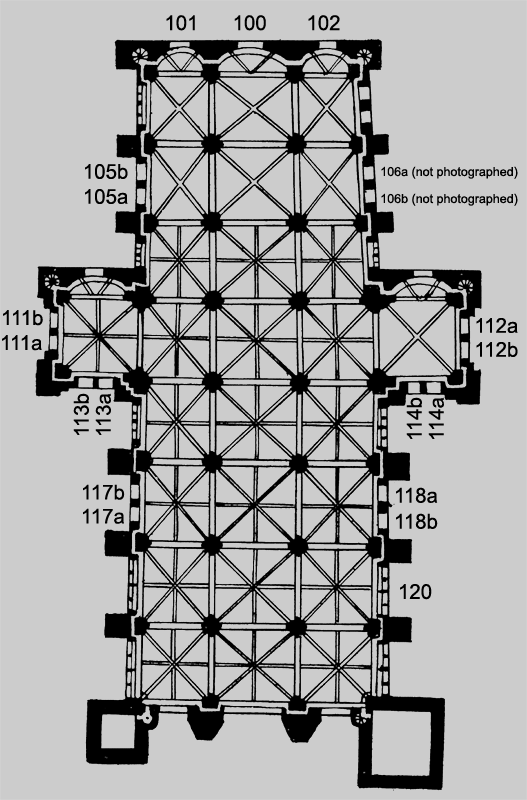MedievalArt.org.uk - Photographs by Stuart Whatling
Poitiers Cathedral - the Medieval Stained Glass


101 - St Laurence (12th Century)
102 - Saints Peter and Paul (12th Century)
105b - Lot / Abraham
105b - Isaac
106b - Passion (not photographed)
111b - Joseph (part 1)
113a - Fragmentary panels from Exodus
113b - Exodus and Life of St Blaise (mixed)
112b - Parable of the Prodigal Son
114a - Parable of the Steward (Luke 16:1-12)
114b - Parable of the Overseer (Mat 20:1-16)
117b - Joshua (part 1)
Poitiers suffered particularly badly during the French Religious Wars. In 1562 the town fell to the Huguenots, who exacted a bloody revenge, not just on the the local populace but even more so, on their churches. Iconoclastic mobs smashed stained glass and defaced paintings wherever they could reach them. This violence, coupled with general neglect in the lean years that followed, left the great early 13th century windows of Poitiers Cathedral as a sad shadow of their original brilliance. Clumsy restorers patched up the missing pieces of early Gothic windows using any stop-gap that would fit; which means one often encounters an incongruous fragment of late medieval silver-stained microarchitecture in a space once occupied by a section of pot-metal drapery. Several panels were lost entirely, some were dispersed to other bays without rhyme or reason, while others were so badly repaired that their contents were rendered illegible. No window escaped unscathed, though some, like the second Joseph window survived sufficiently intact to give a clear impression of the remarkable narrative technique of the Poitevin glaziers. Several missing or damaged panels were replaced in the 20th century by completely new glass painted in a particularly ghastly Art Deco style (done by F Chigot of Limoges in the 'restoration' of 1938-42. Sadly no detailed photographic records were taken before this rather heavy-handed intervention.) Needless to say, I did not photograph any of the modern panels, which are marked in the plans by a darker shade of grey.
Grodecki linked some of the the Poitiers windows with those of one of the three ateliers whose hands he identified at Bourges - the so-called Good Samaritan Workshop. Although Grodecki made this association on the basis of a careful study if traditional connoiseurial criteria such as drapery style and facial types, my own observations of narrative technique and framing (see chapter 9 of my PhD thesis) strongly support his main conclusions. The hypothesis that emerges is that work on the glazing programme at Poitiers began a little before that at Bourges and that at least one of the two or three distinct masters at Poitiers adopted a design approach where the boundaries between panels were treated not as inviolable barriers but as part of the image - a way of linking scenes together or of telling a visually richer story. When work fell behind schedule at Bourges, either this master's atelier, or else another master who had embraced his framing style, traveled from Poitiers to help expedite the project, contributing those bays identified by Grodecki as the work of the Good Samaritan Master. The absence of windows elsewhere in France showing a comparable treatment of framing suggests either that Bourges was his last project - or that subsequent patrons required a more conventional approach. Clever tricks with narrative frames continue to appear in other media, as they had done for centuries beforehand - but in stained glass we find them only at Poitiers and Bourges. Whether it was a local Poitevin tradition shared between multiple workshops and exported thence to Bourges, or the narratological signature of a single glass artist, we may never know.